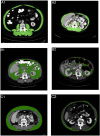A comparative study of software programmes for cross-sectional skeletal muscle and adipose tissue measurements on abdominal computed tomography scans of rectal cancer patients
- PMID: 27897414
- PMCID: PMC5697014
- DOI: 10.1002/jcsm.12158
A comparative study of software programmes for cross-sectional skeletal muscle and adipose tissue measurements on abdominal computed tomography scans of rectal cancer patients
Abstract
Background: The association between body composition (e.g. sarcopenia or visceral obesity) and treatment outcomes, such as survival, using single-slice computed tomography (CT)-based measurements has recently been studied in various patient groups. These studies have been conducted with different software programmes, each with their specific characteristics, of which the inter-observer, intra-observer, and inter-software correlation are unknown. Therefore, a comparative study was performed.
Methods: Fifty abdominal CT scans were randomly selected from 50 different patients and independently assessed by two observers. Cross-sectional muscle area (CSMA, i.e. rectus abdominis, oblique and transverse abdominal muscles, paraspinal muscles, and the psoas muscle), visceral adipose tissue area (VAT), and subcutaneous adipose tissue area (SAT) were segmented by using standard Hounsfield unit ranges and computed for regions of interest. The inter-software, intra-observer, and inter-observer agreement for CSMA, VAT, and SAT measurements using FatSeg, OsiriX, ImageJ, and sliceOmatic were calculated using intra-class correlation coefficients (ICCs) and Bland-Altman analyses. Cohen's κ was calculated for the agreement of sarcopenia and visceral obesity assessment. The Jaccard similarity coefficient was used to compare the similarity and diversity of measurements.
Results: Bland-Altman analyses and ICC indicated that the CSMA, VAT, and SAT measurements between the different software programmes were highly comparable (ICC 0.979-1.000, P < 0.001). All programmes adequately distinguished between the presence or absence of sarcopenia (κ = 0.88-0.96 for one observer and all κ = 1.00 for all comparisons of the other observer) and visceral obesity (all κ = 1.00). Furthermore, excellent intra-observer (ICC 0.999-1.000, P < 0.001) and inter-observer (ICC 0.998-0.999, P < 0.001) agreement for all software programmes were found. Accordingly, excellent Jaccard similarity coefficients were found for all comparisons (mean ≥ 0.964).
Conclusions: FatSeg, OsiriX, ImageJ, and sliceOmatic showed an excellent agreement for CSMA, VAT, and SAT measurements on abdominal CT scans. Furthermore, excellent inter-observer and intra-observer agreement were achieved. Therefore, results of studies using these different software programmes can reliably be compared.
Keywords: Adipose tissue mass; Body composition; Comparability; Computed tomography; Skeletal muscle mass; Software.
© 2016 The Authors. Journal of Cachexia, Sarcopenia and Muscle published by John Wiley & Sons Ltd on behalf of the Society on Sarcopenia, Cachexia and Wasting Disorders.
Figures


References
-
- Leo S, Accettura C, Gnoni A, Licchetta A, Giampaglia M, Mauro A, Saracino V, Carr BI. Systemic treatment of gastrointestinal cancer in elderly patients. J Gastrointest Cancer 2013;44:22–32. - PubMed
-
- Englesbe MJ, Lee JS, He K, Fan L, Schaubel DE, Sheetz KH, Harbaugh CM, Holcombe SA, Campbell DA Jr, Sonnenday CJ, Wang SC. Analytic morphomics, core muscle size, and surgical outcomes. Ann Surg 2012;256:255–61. - PubMed
-
- Fried LP, Hadley EC, Walston JD, Newman AB, Guralnik JM, Studenski S, Harris TB, Ershler WB, Ferrucci L. From bedside to bench: research agenda for frailty. Sci Aging Knowledge Environ 2005;2005:pe24. - PubMed
-
- Tan KY, Kawamura YJ, Tokomitsu A, Tang T. Assessment for frailty is useful for predicting morbidity in elderly patients undergoing colorectal cancer resection whose comorbidities are already optimized. Am J Surg 2012;204:139–43. - PubMed
Publication types
MeSH terms
LinkOut - more resources
Full Text Sources
Other Literature Sources
Research Materials

